Australia Quit Smoking Campaign: Development via Market Research
VerifiedAdded on 2023/05/28
|21
|4518
|135
Report
AI Summary
This report details the development and evaluation of a quit smoking campaign in Australia, focusing on adolescents aged 12-17. It outlines the research methodology, including descriptive research and survey methods, to gather data on smoking habits, reasons for smoking, and intentions to quit. The study employs stratified two-stage probability sampling, involving 5000 students from 50 schools, and uses STATA software for data analysis. Recommendations include increasing tobacco taxes, mass education, prohibiting tobacco sales near schools, and providing counseling and medical support in schools. The report also addresses limitations and suggests further research areas, comparing the challenges of implementing similar campaigns in Australia and Singapore, considering factors like population size, culture, and language. Desklib provides access to this and other solved assignments for students.
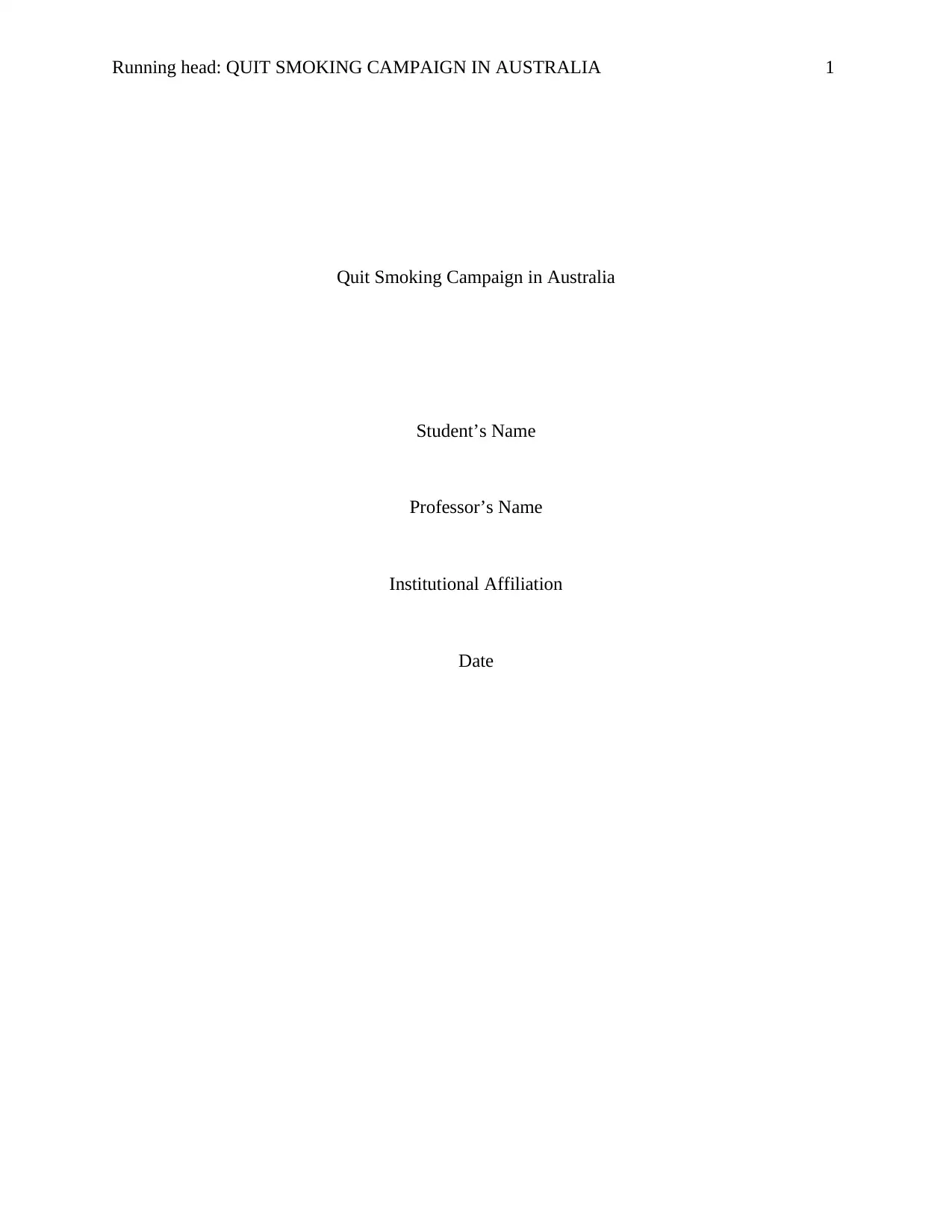
Running head: QUIT SMOKING CAMPAIGN IN AUSTRALIA 1
Quit Smoking Campaign in Australia
Student’s Name
Professor’s Name
Institutional Affiliation
Date
Quit Smoking Campaign in Australia
Student’s Name
Professor’s Name
Institutional Affiliation
Date
Paraphrase This Document
Need a fresh take? Get an instant paraphrase of this document with our AI Paraphraser
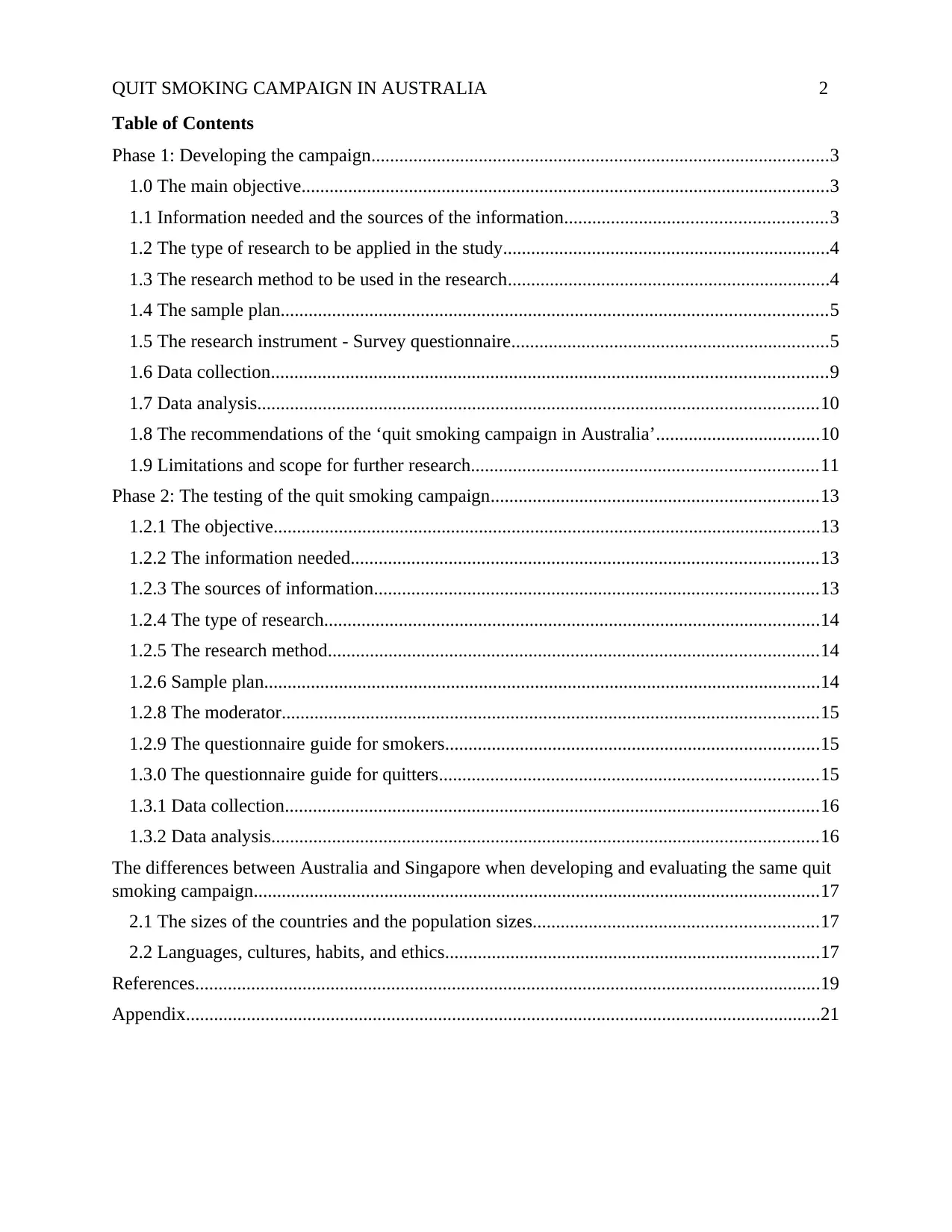
QUIT SMOKING CAMPAIGN IN AUSTRALIA 2
Table of Contents
Phase 1: Developing the campaign..................................................................................................3
1.0 The main objective.................................................................................................................3
1.1 Information needed and the sources of the information........................................................3
1.2 The type of research to be applied in the study......................................................................4
1.3 The research method to be used in the research.....................................................................4
1.4 The sample plan.....................................................................................................................5
1.5 The research instrument - Survey questionnaire....................................................................5
1.6 Data collection.......................................................................................................................9
1.7 Data analysis........................................................................................................................10
1.8 The recommendations of the ‘quit smoking campaign in Australia’...................................10
1.9 Limitations and scope for further research..........................................................................11
Phase 2: The testing of the quit smoking campaign......................................................................13
1.2.1 The objective.....................................................................................................................13
1.2.2 The information needed....................................................................................................13
1.2.3 The sources of information...............................................................................................13
1.2.4 The type of research..........................................................................................................14
1.2.5 The research method.........................................................................................................14
1.2.6 Sample plan.......................................................................................................................14
1.2.8 The moderator...................................................................................................................15
1.2.9 The questionnaire guide for smokers................................................................................15
1.3.0 The questionnaire guide for quitters.................................................................................15
1.3.1 Data collection..................................................................................................................16
1.3.2 Data analysis.....................................................................................................................16
The differences between Australia and Singapore when developing and evaluating the same quit
smoking campaign.........................................................................................................................17
2.1 The sizes of the countries and the population sizes.............................................................17
2.2 Languages, cultures, habits, and ethics................................................................................17
References......................................................................................................................................19
Appendix........................................................................................................................................21
Table of Contents
Phase 1: Developing the campaign..................................................................................................3
1.0 The main objective.................................................................................................................3
1.1 Information needed and the sources of the information........................................................3
1.2 The type of research to be applied in the study......................................................................4
1.3 The research method to be used in the research.....................................................................4
1.4 The sample plan.....................................................................................................................5
1.5 The research instrument - Survey questionnaire....................................................................5
1.6 Data collection.......................................................................................................................9
1.7 Data analysis........................................................................................................................10
1.8 The recommendations of the ‘quit smoking campaign in Australia’...................................10
1.9 Limitations and scope for further research..........................................................................11
Phase 2: The testing of the quit smoking campaign......................................................................13
1.2.1 The objective.....................................................................................................................13
1.2.2 The information needed....................................................................................................13
1.2.3 The sources of information...............................................................................................13
1.2.4 The type of research..........................................................................................................14
1.2.5 The research method.........................................................................................................14
1.2.6 Sample plan.......................................................................................................................14
1.2.8 The moderator...................................................................................................................15
1.2.9 The questionnaire guide for smokers................................................................................15
1.3.0 The questionnaire guide for quitters.................................................................................15
1.3.1 Data collection..................................................................................................................16
1.3.2 Data analysis.....................................................................................................................16
The differences between Australia and Singapore when developing and evaluating the same quit
smoking campaign.........................................................................................................................17
2.1 The sizes of the countries and the population sizes.............................................................17
2.2 Languages, cultures, habits, and ethics................................................................................17
References......................................................................................................................................19
Appendix........................................................................................................................................21
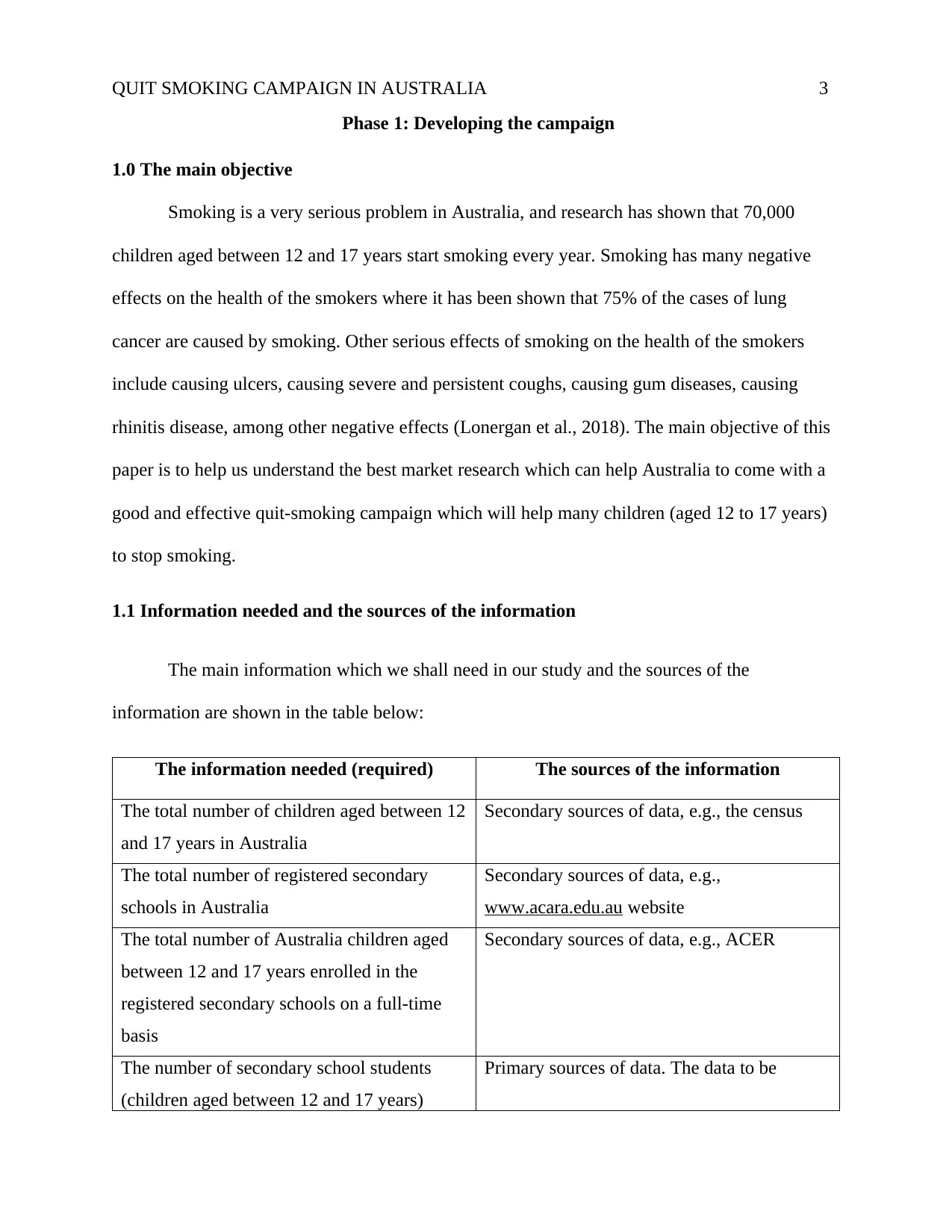
QUIT SMOKING CAMPAIGN IN AUSTRALIA 3
Phase 1: Developing the campaign
1.0 The main objective
Smoking is a very serious problem in Australia, and research has shown that 70,000
children aged between 12 and 17 years start smoking every year. Smoking has many negative
effects on the health of the smokers where it has been shown that 75% of the cases of lung
cancer are caused by smoking. Other serious effects of smoking on the health of the smokers
include causing ulcers, causing severe and persistent coughs, causing gum diseases, causing
rhinitis disease, among other negative effects (Lonergan et al., 2018). The main objective of this
paper is to help us understand the best market research which can help Australia to come with a
good and effective quit-smoking campaign which will help many children (aged 12 to 17 years)
to stop smoking.
1.1 Information needed and the sources of the information
The main information which we shall need in our study and the sources of the
information are shown in the table below:
The information needed (required) The sources of the information
The total number of children aged between 12
and 17 years in Australia
Secondary sources of data, e.g., the census
The total number of registered secondary
schools in Australia
Secondary sources of data, e.g.,
www.acara.edu.au website
The total number of Australia children aged
between 12 and 17 years enrolled in the
registered secondary schools on a full-time
basis
Secondary sources of data, e.g., ACER
The number of secondary school students
(children aged between 12 and 17 years)
Primary sources of data. The data to be
Phase 1: Developing the campaign
1.0 The main objective
Smoking is a very serious problem in Australia, and research has shown that 70,000
children aged between 12 and 17 years start smoking every year. Smoking has many negative
effects on the health of the smokers where it has been shown that 75% of the cases of lung
cancer are caused by smoking. Other serious effects of smoking on the health of the smokers
include causing ulcers, causing severe and persistent coughs, causing gum diseases, causing
rhinitis disease, among other negative effects (Lonergan et al., 2018). The main objective of this
paper is to help us understand the best market research which can help Australia to come with a
good and effective quit-smoking campaign which will help many children (aged 12 to 17 years)
to stop smoking.
1.1 Information needed and the sources of the information
The main information which we shall need in our study and the sources of the
information are shown in the table below:
The information needed (required) The sources of the information
The total number of children aged between 12
and 17 years in Australia
Secondary sources of data, e.g., the census
The total number of registered secondary
schools in Australia
Secondary sources of data, e.g.,
www.acara.edu.au website
The total number of Australia children aged
between 12 and 17 years enrolled in the
registered secondary schools on a full-time
basis
Secondary sources of data, e.g., ACER
The number of secondary school students
(children aged between 12 and 17 years)
Primary sources of data. The data to be
⊘ This is a preview!⊘
Do you want full access?
Subscribe today to unlock all pages.

Trusted by 1+ million students worldwide
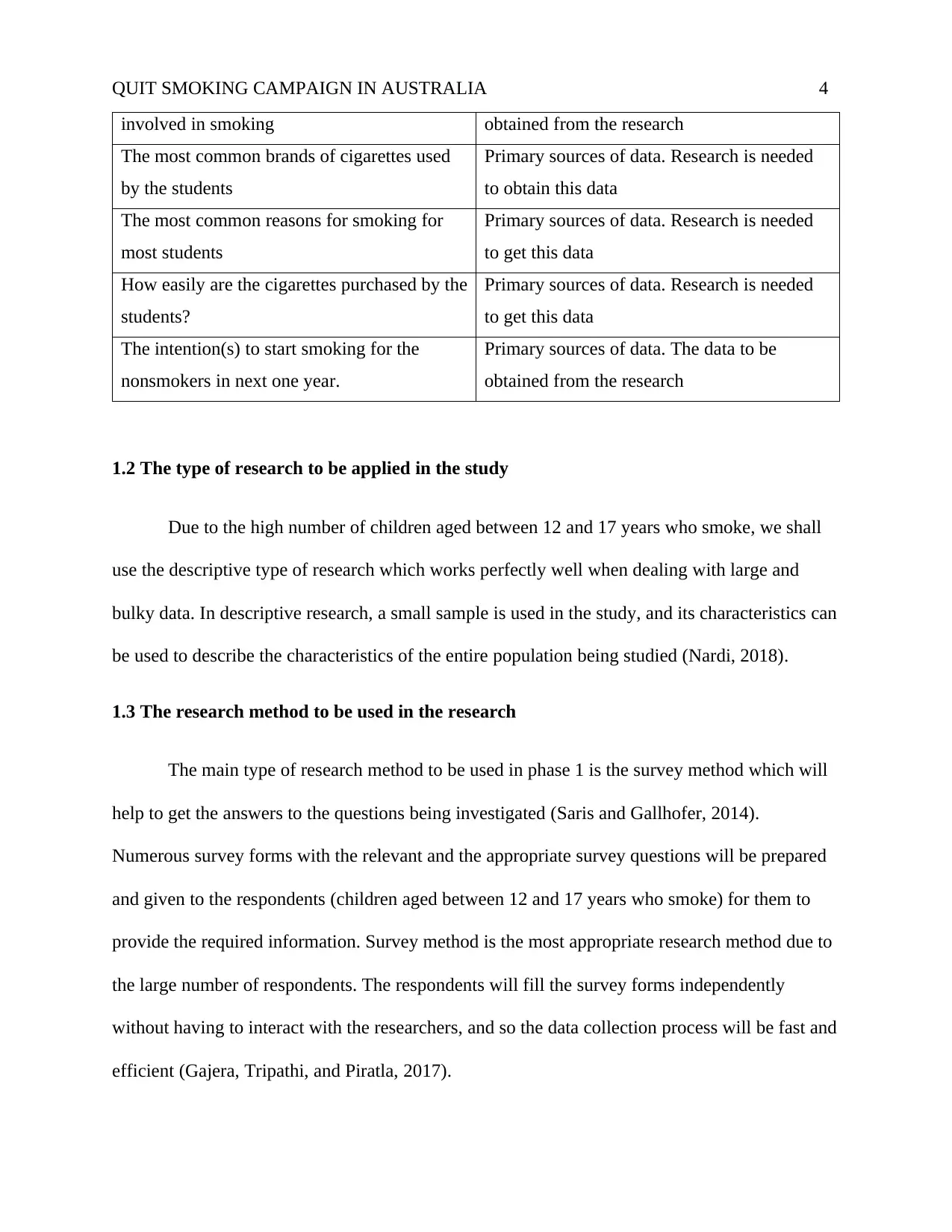
QUIT SMOKING CAMPAIGN IN AUSTRALIA 4
involved in smoking obtained from the research
The most common brands of cigarettes used
by the students
Primary sources of data. Research is needed
to obtain this data
The most common reasons for smoking for
most students
Primary sources of data. Research is needed
to get this data
How easily are the cigarettes purchased by the
students?
Primary sources of data. Research is needed
to get this data
The intention(s) to start smoking for the
nonsmokers in next one year.
Primary sources of data. The data to be
obtained from the research
1.2 The type of research to be applied in the study
Due to the high number of children aged between 12 and 17 years who smoke, we shall
use the descriptive type of research which works perfectly well when dealing with large and
bulky data. In descriptive research, a small sample is used in the study, and its characteristics can
be used to describe the characteristics of the entire population being studied (Nardi, 2018).
1.3 The research method to be used in the research
The main type of research method to be used in phase 1 is the survey method which will
help to get the answers to the questions being investigated (Saris and Gallhofer, 2014).
Numerous survey forms with the relevant and the appropriate survey questions will be prepared
and given to the respondents (children aged between 12 and 17 years who smoke) for them to
provide the required information. Survey method is the most appropriate research method due to
the large number of respondents. The respondents will fill the survey forms independently
without having to interact with the researchers, and so the data collection process will be fast and
efficient (Gajera, Tripathi, and Piratla, 2017).
involved in smoking obtained from the research
The most common brands of cigarettes used
by the students
Primary sources of data. Research is needed
to obtain this data
The most common reasons for smoking for
most students
Primary sources of data. Research is needed
to get this data
How easily are the cigarettes purchased by the
students?
Primary sources of data. Research is needed
to get this data
The intention(s) to start smoking for the
nonsmokers in next one year.
Primary sources of data. The data to be
obtained from the research
1.2 The type of research to be applied in the study
Due to the high number of children aged between 12 and 17 years who smoke, we shall
use the descriptive type of research which works perfectly well when dealing with large and
bulky data. In descriptive research, a small sample is used in the study, and its characteristics can
be used to describe the characteristics of the entire population being studied (Nardi, 2018).
1.3 The research method to be used in the research
The main type of research method to be used in phase 1 is the survey method which will
help to get the answers to the questions being investigated (Saris and Gallhofer, 2014).
Numerous survey forms with the relevant and the appropriate survey questions will be prepared
and given to the respondents (children aged between 12 and 17 years who smoke) for them to
provide the required information. Survey method is the most appropriate research method due to
the large number of respondents. The respondents will fill the survey forms independently
without having to interact with the researchers, and so the data collection process will be fast and
efficient (Gajera, Tripathi, and Piratla, 2017).
Paraphrase This Document
Need a fresh take? Get an instant paraphrase of this document with our AI Paraphraser
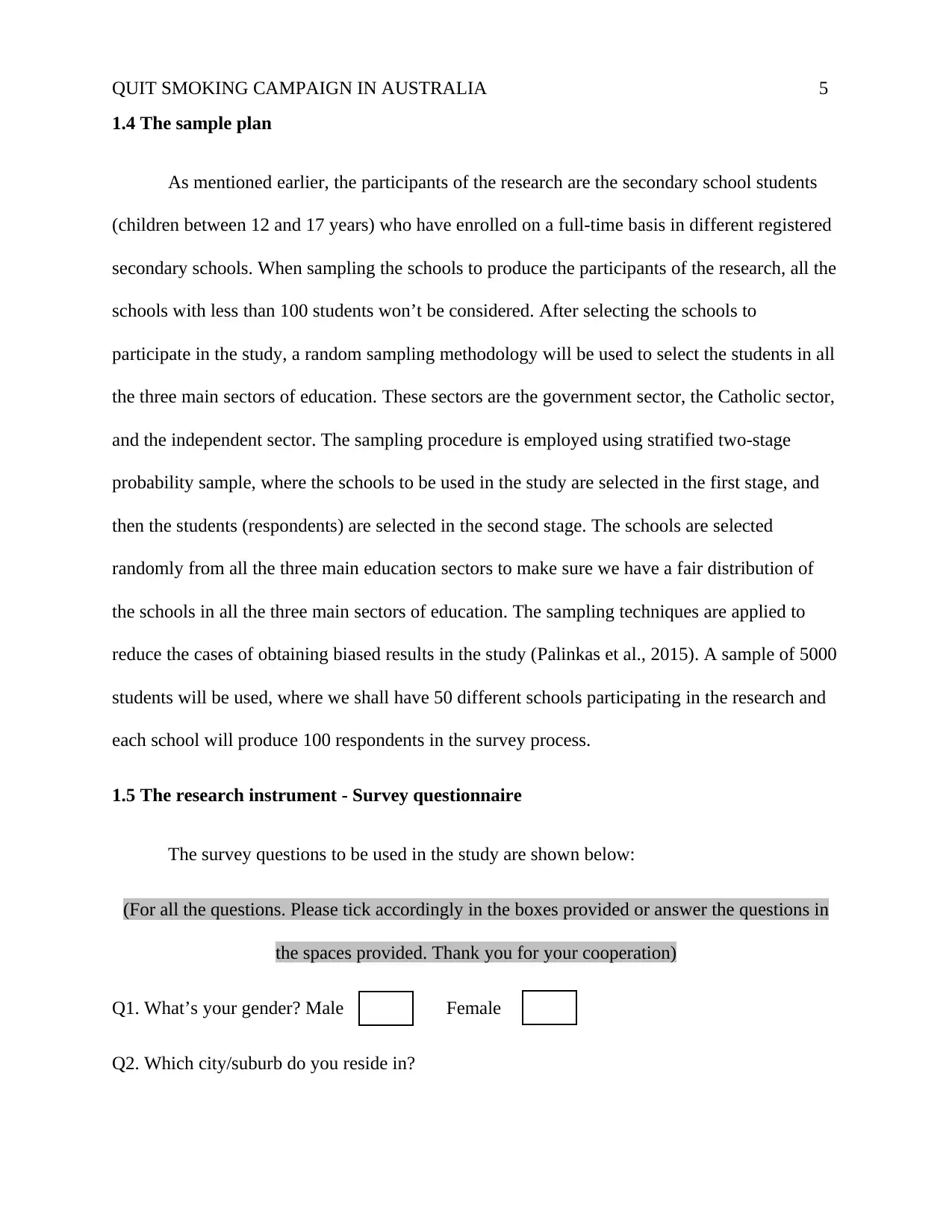
QUIT SMOKING CAMPAIGN IN AUSTRALIA 5
1.4 The sample plan
As mentioned earlier, the participants of the research are the secondary school students
(children between 12 and 17 years) who have enrolled on a full-time basis in different registered
secondary schools. When sampling the schools to produce the participants of the research, all the
schools with less than 100 students won’t be considered. After selecting the schools to
participate in the study, a random sampling methodology will be used to select the students in all
the three main sectors of education. These sectors are the government sector, the Catholic sector,
and the independent sector. The sampling procedure is employed using stratified two-stage
probability sample, where the schools to be used in the study are selected in the first stage, and
then the students (respondents) are selected in the second stage. The schools are selected
randomly from all the three main education sectors to make sure we have a fair distribution of
the schools in all the three main sectors of education. The sampling techniques are applied to
reduce the cases of obtaining biased results in the study (Palinkas et al., 2015). A sample of 5000
students will be used, where we shall have 50 different schools participating in the research and
each school will produce 100 respondents in the survey process.
1.5 The research instrument - Survey questionnaire
The survey questions to be used in the study are shown below:
(For all the questions. Please tick accordingly in the boxes provided or answer the questions in
the spaces provided. Thank you for your cooperation)
Q1. What’s your gender? Male Female
Q2. Which city/suburb do you reside in?
1.4 The sample plan
As mentioned earlier, the participants of the research are the secondary school students
(children between 12 and 17 years) who have enrolled on a full-time basis in different registered
secondary schools. When sampling the schools to produce the participants of the research, all the
schools with less than 100 students won’t be considered. After selecting the schools to
participate in the study, a random sampling methodology will be used to select the students in all
the three main sectors of education. These sectors are the government sector, the Catholic sector,
and the independent sector. The sampling procedure is employed using stratified two-stage
probability sample, where the schools to be used in the study are selected in the first stage, and
then the students (respondents) are selected in the second stage. The schools are selected
randomly from all the three main education sectors to make sure we have a fair distribution of
the schools in all the three main sectors of education. The sampling techniques are applied to
reduce the cases of obtaining biased results in the study (Palinkas et al., 2015). A sample of 5000
students will be used, where we shall have 50 different schools participating in the research and
each school will produce 100 respondents in the survey process.
1.5 The research instrument - Survey questionnaire
The survey questions to be used in the study are shown below:
(For all the questions. Please tick accordingly in the boxes provided or answer the questions in
the spaces provided. Thank you for your cooperation)
Q1. What’s your gender? Male Female
Q2. Which city/suburb do you reside in?
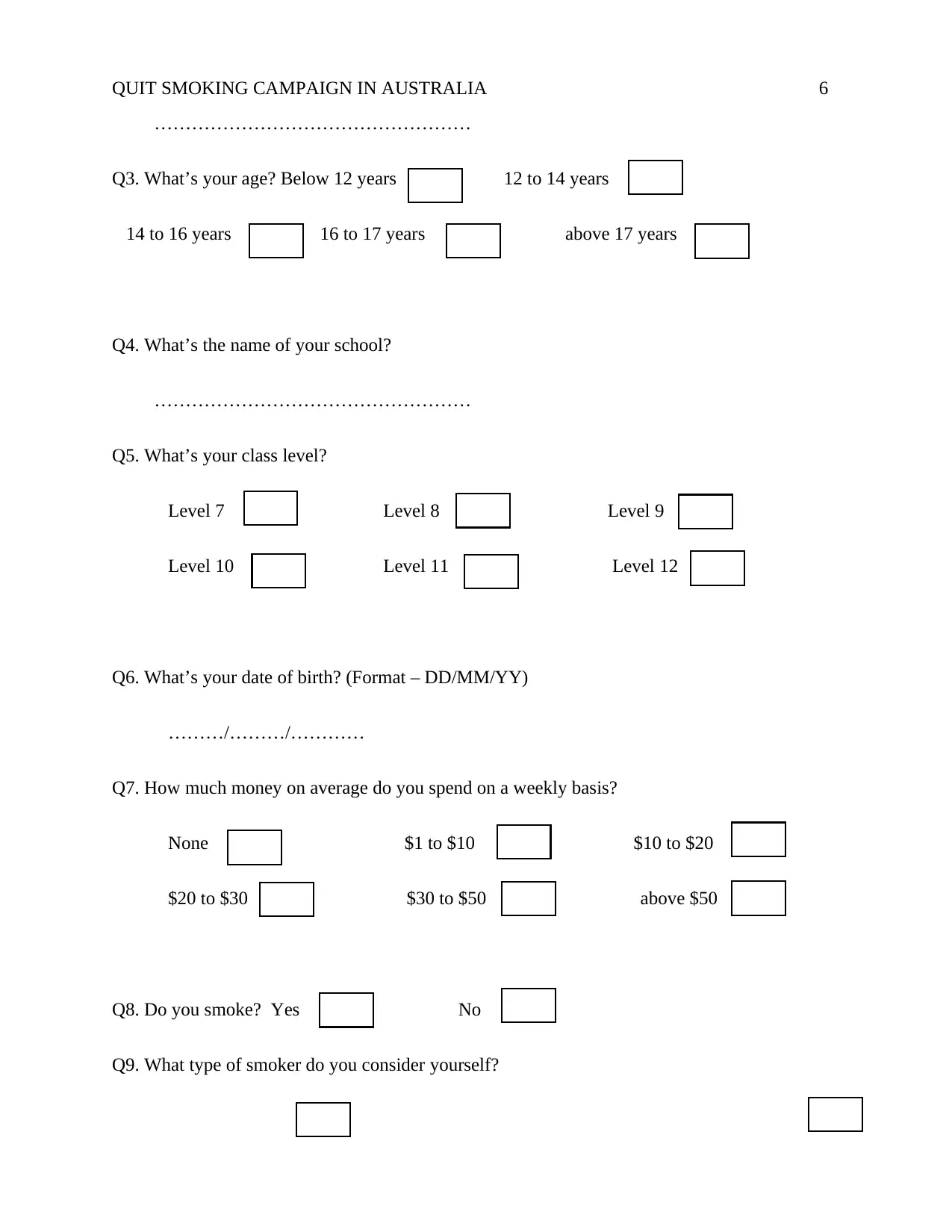
QUIT SMOKING CAMPAIGN IN AUSTRALIA 6
……………………………………………
Q3. What’s your age? Below 12 years 12 to 14 years
14 to 16 years 16 to 17 years above 17 years
Q4. What’s the name of your school?
……………………………………………
Q5. What’s your class level?
Level 7 Level 8 Level 9
Level 10 Level 11 Level 12
Q6. What’s your date of birth? (Format – DD/MM/YY)
………/………/…………
Q7. How much money on average do you spend on a weekly basis?
None $1 to $10 $10 to $20
$20 to $30 $30 to $50 above $50
Q8. Do you smoke? Yes No
Q9. What type of smoker do you consider yourself?
……………………………………………
Q3. What’s your age? Below 12 years 12 to 14 years
14 to 16 years 16 to 17 years above 17 years
Q4. What’s the name of your school?
……………………………………………
Q5. What’s your class level?
Level 7 Level 8 Level 9
Level 10 Level 11 Level 12
Q6. What’s your date of birth? (Format – DD/MM/YY)
………/………/…………
Q7. How much money on average do you spend on a weekly basis?
None $1 to $10 $10 to $20
$20 to $30 $30 to $50 above $50
Q8. Do you smoke? Yes No
Q9. What type of smoker do you consider yourself?
⊘ This is a preview!⊘
Do you want full access?
Subscribe today to unlock all pages.

Trusted by 1+ million students worldwide
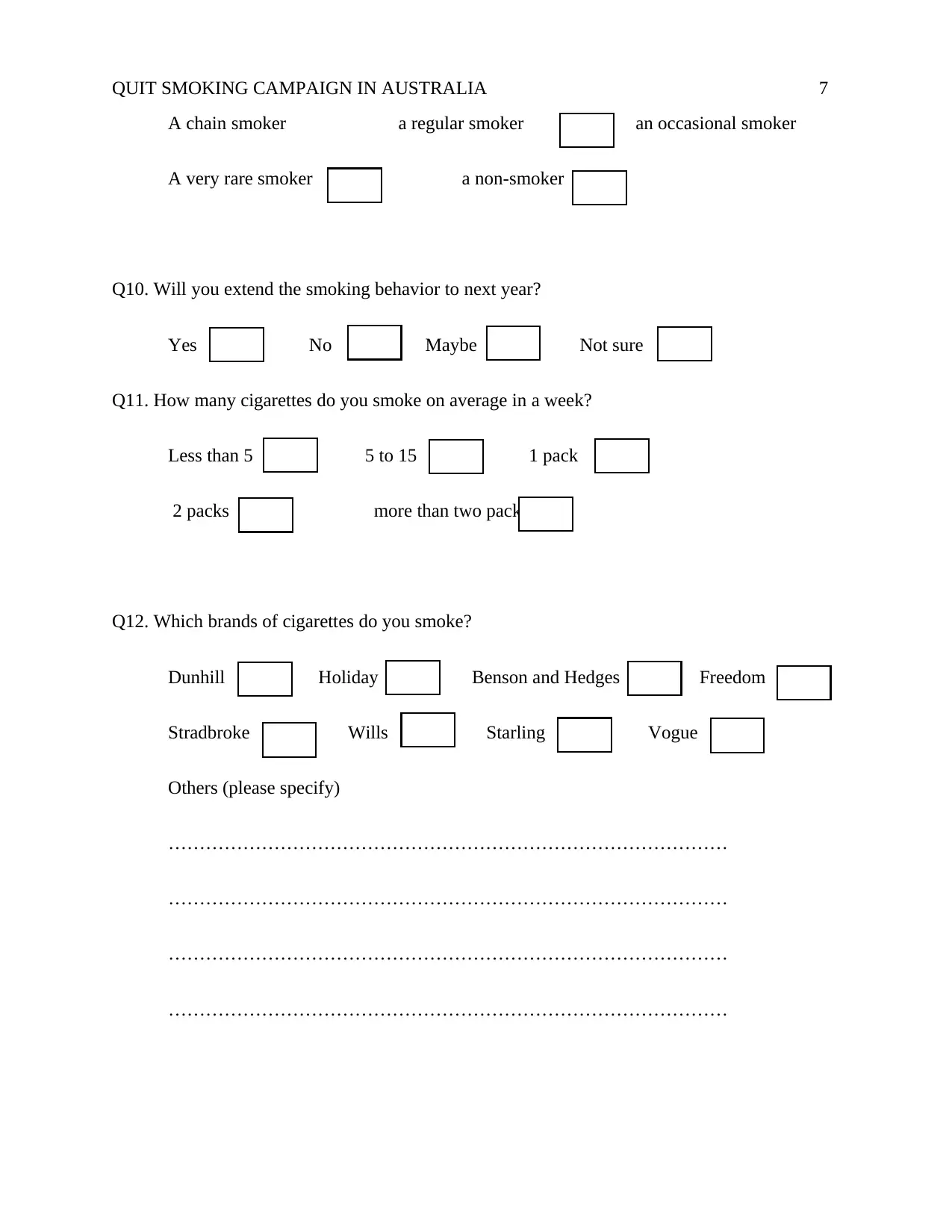
QUIT SMOKING CAMPAIGN IN AUSTRALIA 7
A chain smoker a regular smoker an occasional smoker
A very rare smoker a non-smoker
Q10. Will you extend the smoking behavior to next year?
Yes No Maybe Not sure
Q11. How many cigarettes do you smoke on average in a week?
Less than 5 5 to 15 1 pack
2 packs more than two packs
Q12. Which brands of cigarettes do you smoke?
Dunhill Holiday Benson and Hedges Freedom
Stradbroke Wills Starling Vogue
Others (please specify)
………………………………………………………………………………
………………………………………………………………………………
………………………………………………………………………………
………………………………………………………………………………
A chain smoker a regular smoker an occasional smoker
A very rare smoker a non-smoker
Q10. Will you extend the smoking behavior to next year?
Yes No Maybe Not sure
Q11. How many cigarettes do you smoke on average in a week?
Less than 5 5 to 15 1 pack
2 packs more than two packs
Q12. Which brands of cigarettes do you smoke?
Dunhill Holiday Benson and Hedges Freedom
Stradbroke Wills Starling Vogue
Others (please specify)
………………………………………………………………………………
………………………………………………………………………………
………………………………………………………………………………
………………………………………………………………………………
Paraphrase This Document
Need a fresh take? Get an instant paraphrase of this document with our AI Paraphraser
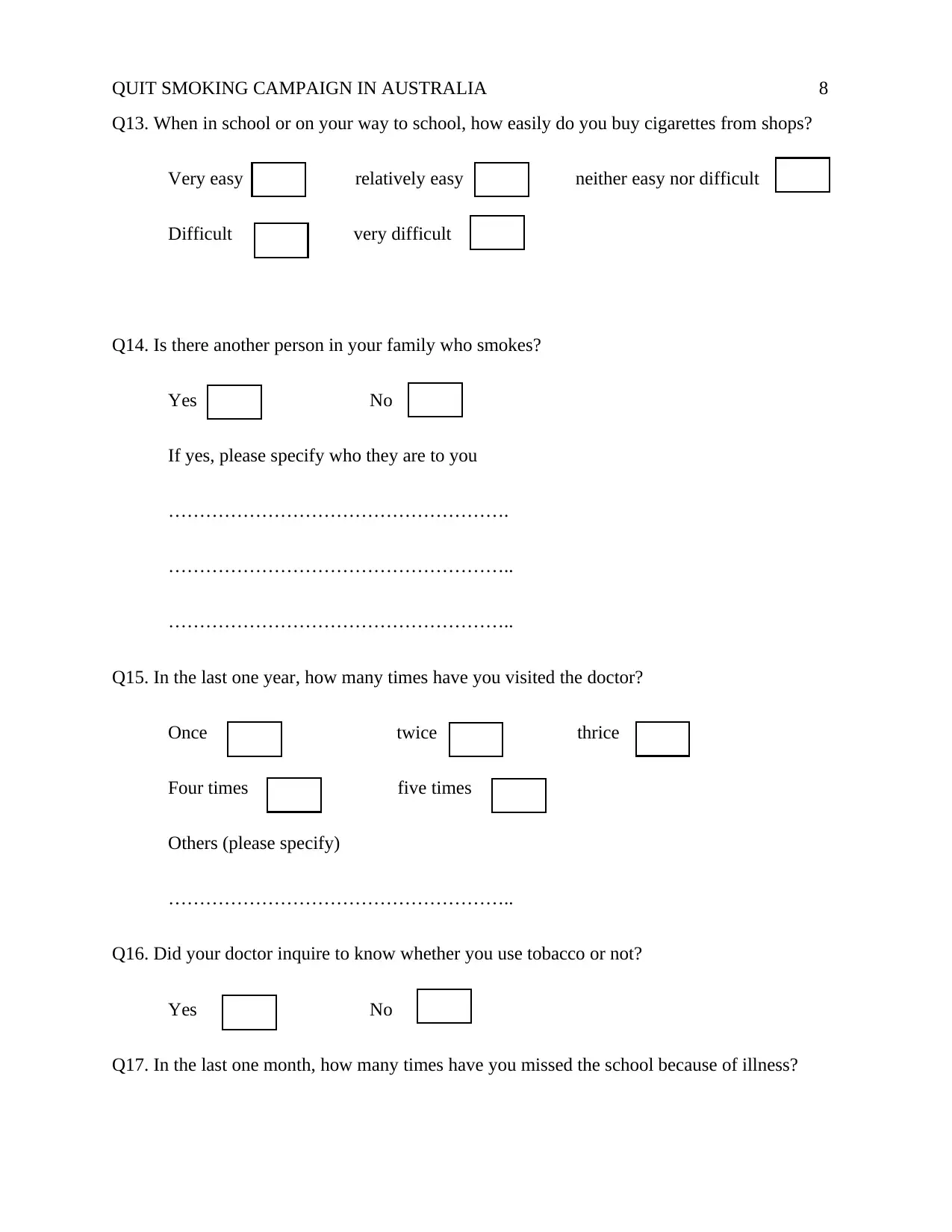
QUIT SMOKING CAMPAIGN IN AUSTRALIA 8
Q13. When in school or on your way to school, how easily do you buy cigarettes from shops?
Very easy relatively easy neither easy nor difficult
Difficult very difficult
Q14. Is there another person in your family who smokes?
Yes No
If yes, please specify who they are to you
……………………………………………….
………………………………………………..
………………………………………………..
Q15. In the last one year, how many times have you visited the doctor?
Once twice thrice
Four times five times
Others (please specify)
………………………………………………..
Q16. Did your doctor inquire to know whether you use tobacco or not?
Yes No
Q17. In the last one month, how many times have you missed the school because of illness?
Q13. When in school or on your way to school, how easily do you buy cigarettes from shops?
Very easy relatively easy neither easy nor difficult
Difficult very difficult
Q14. Is there another person in your family who smokes?
Yes No
If yes, please specify who they are to you
……………………………………………….
………………………………………………..
………………………………………………..
Q15. In the last one year, how many times have you visited the doctor?
Once twice thrice
Four times five times
Others (please specify)
………………………………………………..
Q16. Did your doctor inquire to know whether you use tobacco or not?
Yes No
Q17. In the last one month, how many times have you missed the school because of illness?
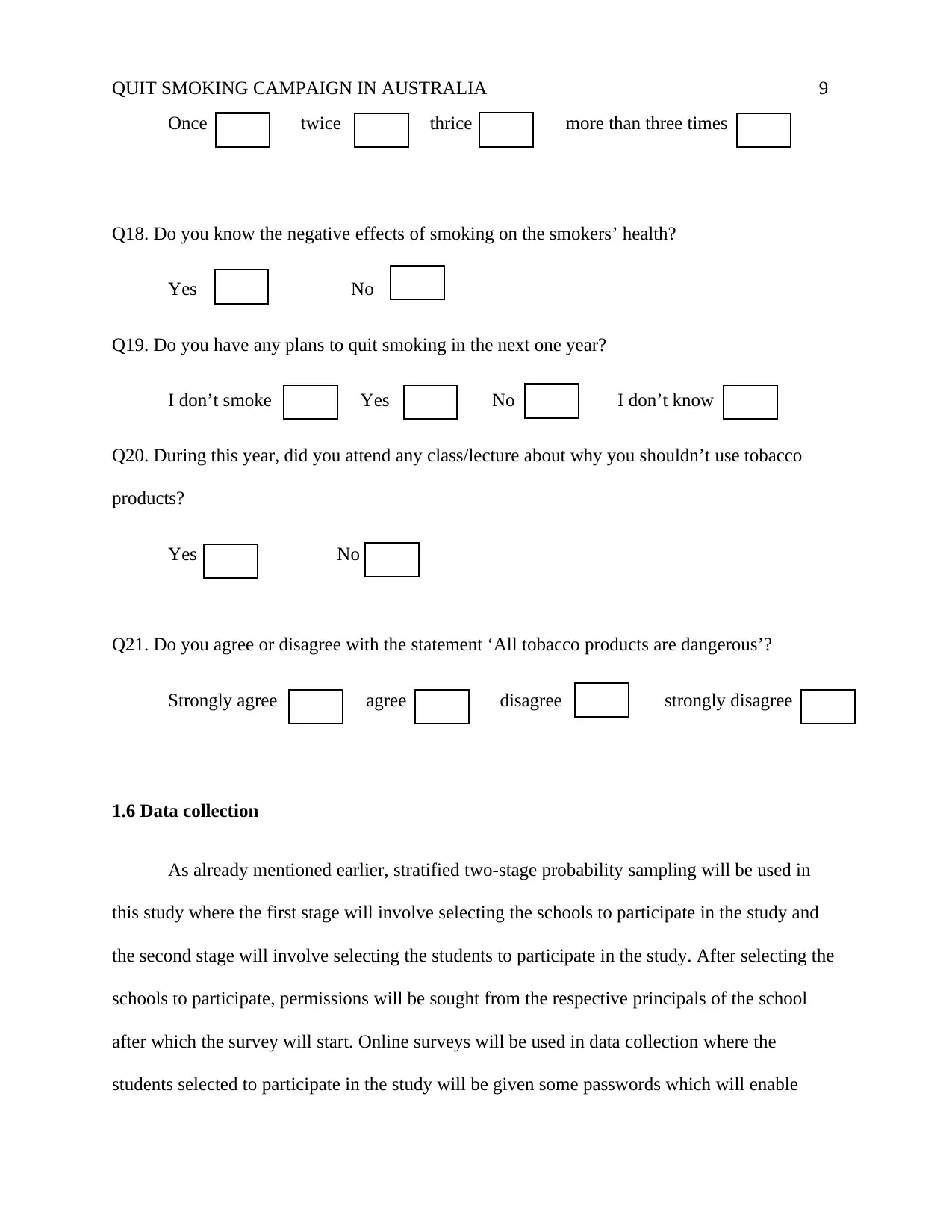
QUIT SMOKING CAMPAIGN IN AUSTRALIA 9
Once twice thrice more than three times
Q18. Do you know the negative effects of smoking on the smokers’ health?
Yes No
Q19. Do you have any plans to quit smoking in the next one year?
I don’t smoke Yes No I don’t know
Q20. During this year, did you attend any class/lecture about why you shouldn’t use tobacco
products?
Yes No
Q21. Do you agree or disagree with the statement ‘All tobacco products are dangerous’?
Strongly agree agree disagree strongly disagree
1.6 Data collection
As already mentioned earlier, stratified two-stage probability sampling will be used in
this study where the first stage will involve selecting the schools to participate in the study and
the second stage will involve selecting the students to participate in the study. After selecting the
schools to participate, permissions will be sought from the respective principals of the school
after which the survey will start. Online surveys will be used in data collection where the
students selected to participate in the study will be given some passwords which will enable
Once twice thrice more than three times
Q18. Do you know the negative effects of smoking on the smokers’ health?
Yes No
Q19. Do you have any plans to quit smoking in the next one year?
I don’t smoke Yes No I don’t know
Q20. During this year, did you attend any class/lecture about why you shouldn’t use tobacco
products?
Yes No
Q21. Do you agree or disagree with the statement ‘All tobacco products are dangerous’?
Strongly agree agree disagree strongly disagree
1.6 Data collection
As already mentioned earlier, stratified two-stage probability sampling will be used in
this study where the first stage will involve selecting the schools to participate in the study and
the second stage will involve selecting the students to participate in the study. After selecting the
schools to participate, permissions will be sought from the respective principals of the school
after which the survey will start. Online surveys will be used in data collection where the
students selected to participate in the study will be given some passwords which will enable
⊘ This is a preview!⊘
Do you want full access?
Subscribe today to unlock all pages.

Trusted by 1+ million students worldwide
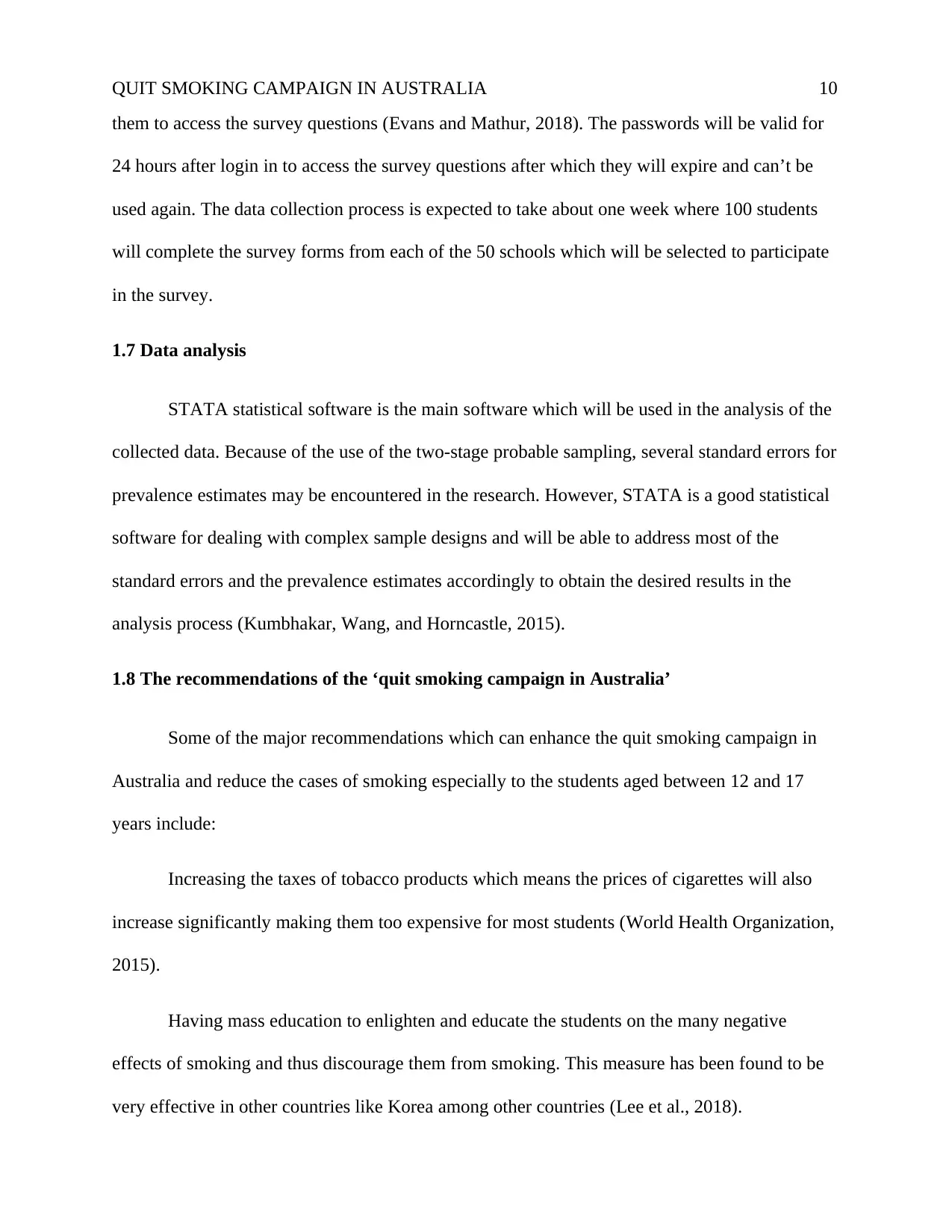
QUIT SMOKING CAMPAIGN IN AUSTRALIA 10
them to access the survey questions (Evans and Mathur, 2018). The passwords will be valid for
24 hours after login in to access the survey questions after which they will expire and can’t be
used again. The data collection process is expected to take about one week where 100 students
will complete the survey forms from each of the 50 schools which will be selected to participate
in the survey.
1.7 Data analysis
STATA statistical software is the main software which will be used in the analysis of the
collected data. Because of the use of the two-stage probable sampling, several standard errors for
prevalence estimates may be encountered in the research. However, STATA is a good statistical
software for dealing with complex sample designs and will be able to address most of the
standard errors and the prevalence estimates accordingly to obtain the desired results in the
analysis process (Kumbhakar, Wang, and Horncastle, 2015).
1.8 The recommendations of the ‘quit smoking campaign in Australia’
Some of the major recommendations which can enhance the quit smoking campaign in
Australia and reduce the cases of smoking especially to the students aged between 12 and 17
years include:
Increasing the taxes of tobacco products which means the prices of cigarettes will also
increase significantly making them too expensive for most students (World Health Organization,
2015).
Having mass education to enlighten and educate the students on the many negative
effects of smoking and thus discourage them from smoking. This measure has been found to be
very effective in other countries like Korea among other countries (Lee et al., 2018).
them to access the survey questions (Evans and Mathur, 2018). The passwords will be valid for
24 hours after login in to access the survey questions after which they will expire and can’t be
used again. The data collection process is expected to take about one week where 100 students
will complete the survey forms from each of the 50 schools which will be selected to participate
in the survey.
1.7 Data analysis
STATA statistical software is the main software which will be used in the analysis of the
collected data. Because of the use of the two-stage probable sampling, several standard errors for
prevalence estimates may be encountered in the research. However, STATA is a good statistical
software for dealing with complex sample designs and will be able to address most of the
standard errors and the prevalence estimates accordingly to obtain the desired results in the
analysis process (Kumbhakar, Wang, and Horncastle, 2015).
1.8 The recommendations of the ‘quit smoking campaign in Australia’
Some of the major recommendations which can enhance the quit smoking campaign in
Australia and reduce the cases of smoking especially to the students aged between 12 and 17
years include:
Increasing the taxes of tobacco products which means the prices of cigarettes will also
increase significantly making them too expensive for most students (World Health Organization,
2015).
Having mass education to enlighten and educate the students on the many negative
effects of smoking and thus discourage them from smoking. This measure has been found to be
very effective in other countries like Korea among other countries (Lee et al., 2018).
Paraphrase This Document
Need a fresh take? Get an instant paraphrase of this document with our AI Paraphraser
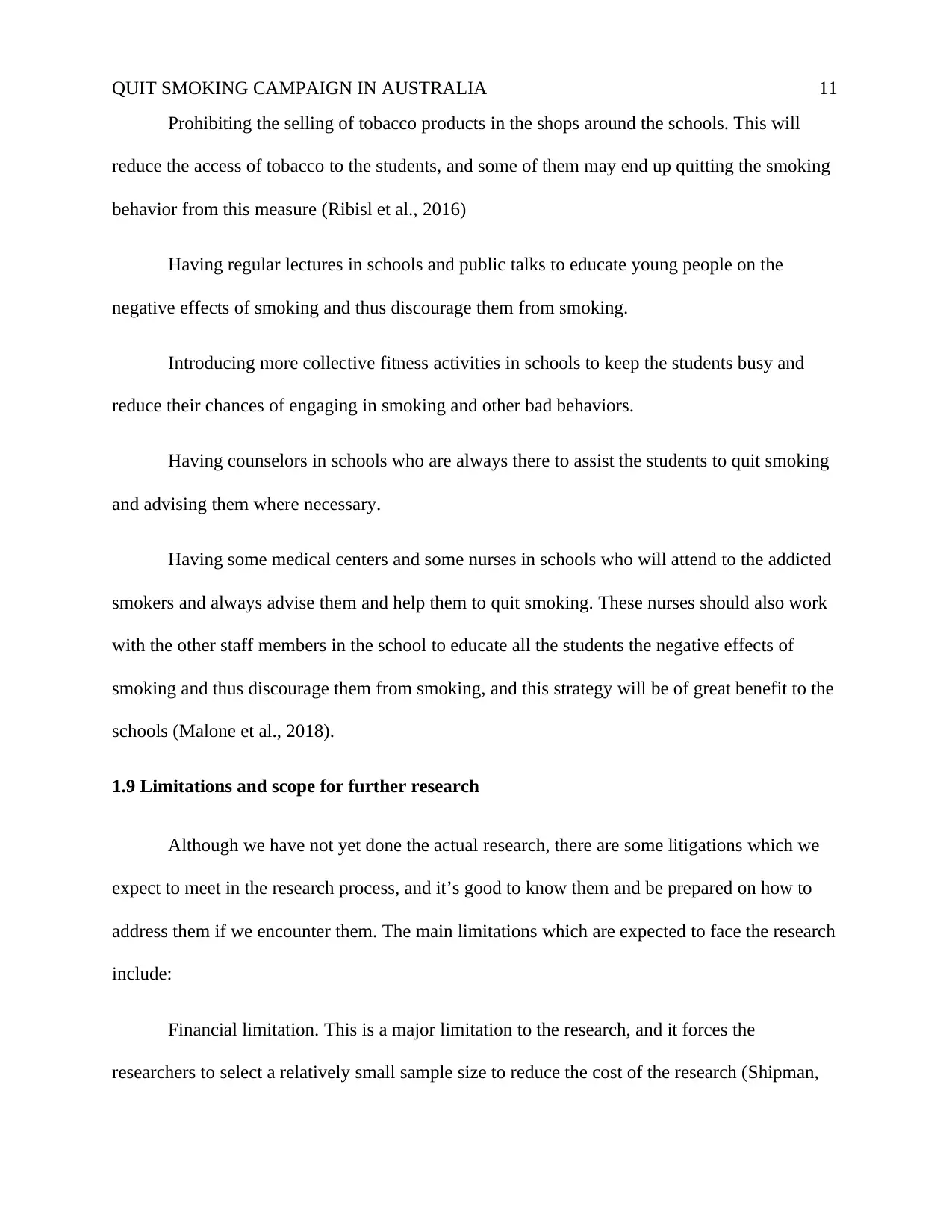
QUIT SMOKING CAMPAIGN IN AUSTRALIA 11
Prohibiting the selling of tobacco products in the shops around the schools. This will
reduce the access of tobacco to the students, and some of them may end up quitting the smoking
behavior from this measure (Ribisl et al., 2016)
Having regular lectures in schools and public talks to educate young people on the
negative effects of smoking and thus discourage them from smoking.
Introducing more collective fitness activities in schools to keep the students busy and
reduce their chances of engaging in smoking and other bad behaviors.
Having counselors in schools who are always there to assist the students to quit smoking
and advising them where necessary.
Having some medical centers and some nurses in schools who will attend to the addicted
smokers and always advise them and help them to quit smoking. These nurses should also work
with the other staff members in the school to educate all the students the negative effects of
smoking and thus discourage them from smoking, and this strategy will be of great benefit to the
schools (Malone et al., 2018).
1.9 Limitations and scope for further research
Although we have not yet done the actual research, there are some litigations which we
expect to meet in the research process, and it’s good to know them and be prepared on how to
address them if we encounter them. The main limitations which are expected to face the research
include:
Financial limitation. This is a major limitation to the research, and it forces the
researchers to select a relatively small sample size to reduce the cost of the research (Shipman,
Prohibiting the selling of tobacco products in the shops around the schools. This will
reduce the access of tobacco to the students, and some of them may end up quitting the smoking
behavior from this measure (Ribisl et al., 2016)
Having regular lectures in schools and public talks to educate young people on the
negative effects of smoking and thus discourage them from smoking.
Introducing more collective fitness activities in schools to keep the students busy and
reduce their chances of engaging in smoking and other bad behaviors.
Having counselors in schools who are always there to assist the students to quit smoking
and advising them where necessary.
Having some medical centers and some nurses in schools who will attend to the addicted
smokers and always advise them and help them to quit smoking. These nurses should also work
with the other staff members in the school to educate all the students the negative effects of
smoking and thus discourage them from smoking, and this strategy will be of great benefit to the
schools (Malone et al., 2018).
1.9 Limitations and scope for further research
Although we have not yet done the actual research, there are some litigations which we
expect to meet in the research process, and it’s good to know them and be prepared on how to
address them if we encounter them. The main limitations which are expected to face the research
include:
Financial limitation. This is a major limitation to the research, and it forces the
researchers to select a relatively small sample size to reduce the cost of the research (Shipman,
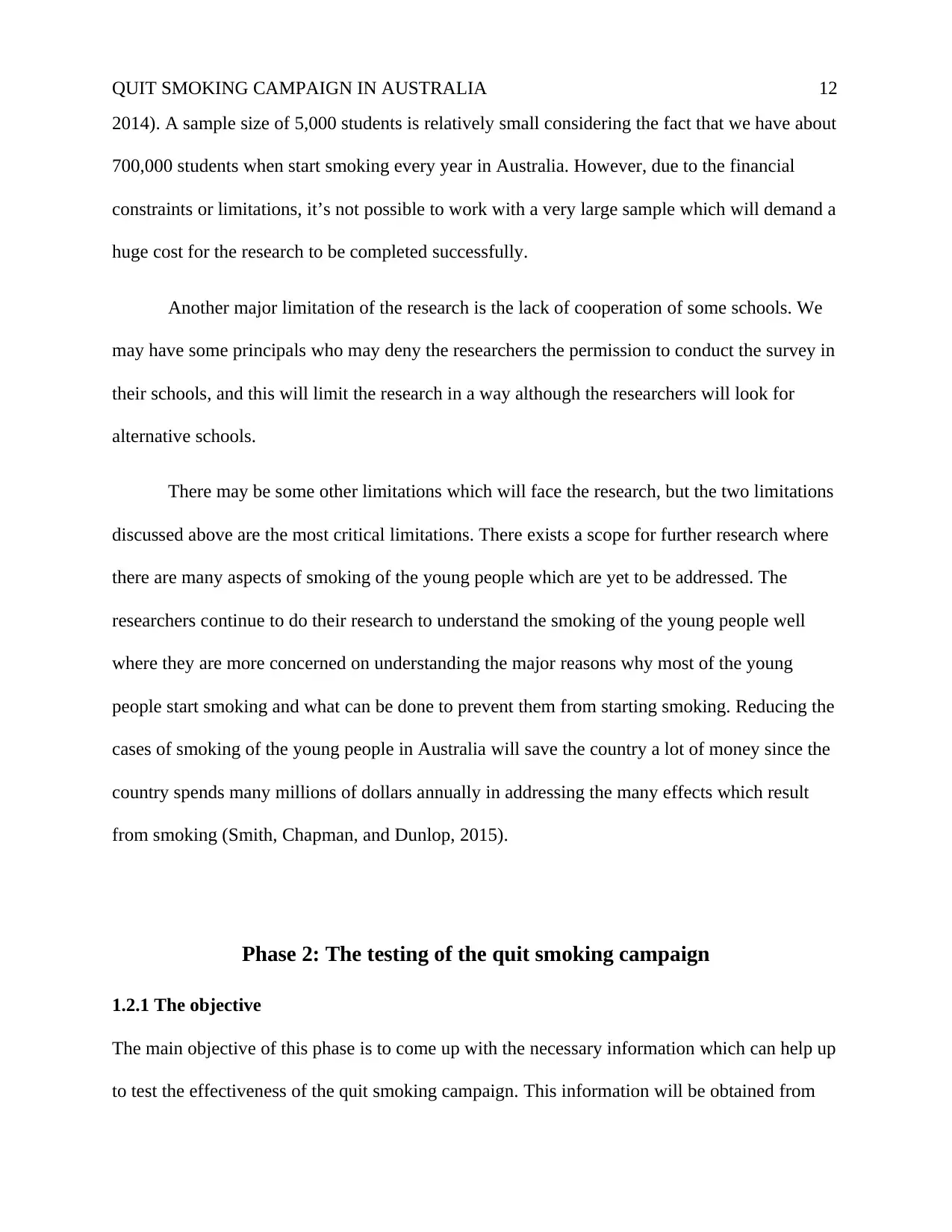
QUIT SMOKING CAMPAIGN IN AUSTRALIA 12
2014). A sample size of 5,000 students is relatively small considering the fact that we have about
700,000 students when start smoking every year in Australia. However, due to the financial
constraints or limitations, it’s not possible to work with a very large sample which will demand a
huge cost for the research to be completed successfully.
Another major limitation of the research is the lack of cooperation of some schools. We
may have some principals who may deny the researchers the permission to conduct the survey in
their schools, and this will limit the research in a way although the researchers will look for
alternative schools.
There may be some other limitations which will face the research, but the two limitations
discussed above are the most critical limitations. There exists a scope for further research where
there are many aspects of smoking of the young people which are yet to be addressed. The
researchers continue to do their research to understand the smoking of the young people well
where they are more concerned on understanding the major reasons why most of the young
people start smoking and what can be done to prevent them from starting smoking. Reducing the
cases of smoking of the young people in Australia will save the country a lot of money since the
country spends many millions of dollars annually in addressing the many effects which result
from smoking (Smith, Chapman, and Dunlop, 2015).
Phase 2: The testing of the quit smoking campaign
1.2.1 The objective
The main objective of this phase is to come up with the necessary information which can help up
to test the effectiveness of the quit smoking campaign. This information will be obtained from
2014). A sample size of 5,000 students is relatively small considering the fact that we have about
700,000 students when start smoking every year in Australia. However, due to the financial
constraints or limitations, it’s not possible to work with a very large sample which will demand a
huge cost for the research to be completed successfully.
Another major limitation of the research is the lack of cooperation of some schools. We
may have some principals who may deny the researchers the permission to conduct the survey in
their schools, and this will limit the research in a way although the researchers will look for
alternative schools.
There may be some other limitations which will face the research, but the two limitations
discussed above are the most critical limitations. There exists a scope for further research where
there are many aspects of smoking of the young people which are yet to be addressed. The
researchers continue to do their research to understand the smoking of the young people well
where they are more concerned on understanding the major reasons why most of the young
people start smoking and what can be done to prevent them from starting smoking. Reducing the
cases of smoking of the young people in Australia will save the country a lot of money since the
country spends many millions of dollars annually in addressing the many effects which result
from smoking (Smith, Chapman, and Dunlop, 2015).
Phase 2: The testing of the quit smoking campaign
1.2.1 The objective
The main objective of this phase is to come up with the necessary information which can help up
to test the effectiveness of the quit smoking campaign. This information will be obtained from
⊘ This is a preview!⊘
Do you want full access?
Subscribe today to unlock all pages.

Trusted by 1+ million students worldwide
1 out of 21
Related Documents
Your All-in-One AI-Powered Toolkit for Academic Success.
+13062052269
info@desklib.com
Available 24*7 on WhatsApp / Email
![[object Object]](/_next/static/media/star-bottom.7253800d.svg)
Unlock your academic potential
Copyright © 2020–2025 A2Z Services. All Rights Reserved. Developed and managed by ZUCOL.





